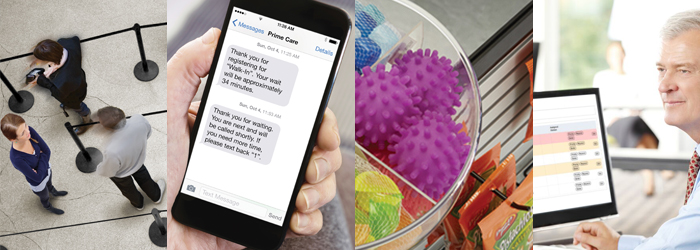
4 cualidades de una fila de cajas exitosa

As a retailer or other brick-and-mortar service provider, one of your most critical goals is to design a service or checkout line system that addresses the expectations of your customers, the characteristics of your checkout process, and the long-term strategy of your organization. It’s certainly possible to simultaneously focus on all of these areas, ultimately forwarding your goals as a business and your reputation as an establishment with high-quality customer service. The most successful retailers and service providers have developed winning checkout lines by directing their energy toward the following ideals:
1. The checkout line is a priority.
Whether a business employs a multiple line, single line, or no line at all, whether they have one service station or many, first and foremost, the commitment must be made to place a high priority on the checkout line as a source of competitive advantage, customer satisfaction, and profits. Managers, decision makers, and staff alike must be well aware of the dangers of a poorly run checkout line and the benefits of one that is well-devised. Any business that ignores the importance of the checkout line or considers it negligible will experience a great deal of lost customers, cart abandonment, and drive-bys.
2. The checkout line is responsive to rushes and lulls.
Thriving businesses are aware that ebbs and flows in customer flow can make or break sales, and make or break return customers. Retailers and other businesses that exhibit an advantage over competitors are paying close attention to what’s happening in their checkout lines and making adjustments as necessary, e.g., cashier stations are quickly opened as needed, staff are shifted away from lower priority tasks to assist in getting people through the checkout line. Furthermore, managers are ready with an appropriate employee-to-customer ratio in key departments.
3. Proactive queue monitoring is in place.
Retailers who monitor their queues and make customer wait time a key performance indicator have an edge. Accurate and continuous counting of traffic entering the store, along with measurement of queue and transaction times for each customer in the queue, is just the beginning. Technologically advanced behavior measurement systems can take this a step further by using predictive queue monitoring to respond to demand and improve staffing allocations – all of which improves the customer experience and the company’s profitability.
4. The right equipment is on hand.
Queuing products help facilitate an orderly waiting line, furthering an establishment’s distinction as customer-friendly. Stanchions with retractable belts allow for the switching up of a queue’s pattern to accommodate heavy crowds or a small flow of people. Queue signage makes the entrance to a line clear, while station lights and electronic queuing can be implemented to direct the next customer to an open station, minimizing actual and perceived wait times. And, of course, integrated in-queue merchandising displays keeps customers occupied while maximizing impulse sales. Executing and managing a smart checkout line must become a top priority for service-oriented environments. The determination to make the customer experience excellent, streamlined, and pleasant will deliver much in return. Talk to a Lavi expert about how your checkout line can be improved.
SUSCRIBIRSE
Suscríbase para mantenerse al día con los nuevos productos, información y noticias sobre los recursos.
ENTRADAS DE BLOG RECIENTES
Theft at the Register: How Strategic Queue Design Protects Profits
Leer el artículo completoRapid Deployment Crowd Control: JetTrac Portable Barriers For The Biggest Spaces
Leer el artículo completo4 Psychological Reasons Your Customers Hate Waiting In Line
Leer el artículo completoFrom Bleachers To Bookstores: 4 Campus Crowd Control Solutions
Leer el artículo completo








